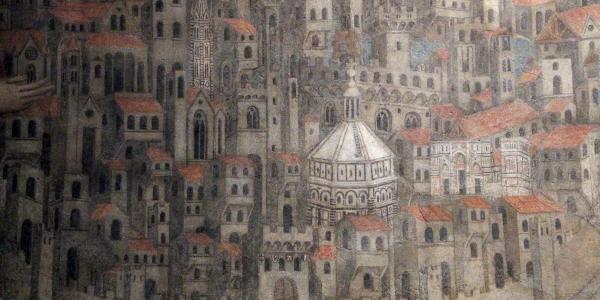Michael Sherberg is professor of Italian in the Department of Romance Languages and Literatures.
In the early spring of 1354, having delivered his Lenten sermons in the Florentine church of Santa Maria Novella, the Dominican friar Jacopo Passavanti set about to organize them into a book. He envisioned the Mirror of True Penitence, left unfinished at his death three years later, as part of a larger project: the Italian text for the lay reader, and a second version, in Latin and with greater theological depth, for clerics.
Passavanti laid out six topics: a definition of penitence; the inducements to repentance; the obstacles; and discussions of the three parts of penitence, contrition, confession and satisfaction. After a while the plan founders on an extended discussion of pride, and a lengthy treatise on dreams. The approach feels familiar to readers of medieval texts, as it treads the well-worn path of citation. In addition to the Bible, there is a variety of theological sources, both Church fathers and others. Passavanti leavens the text with lively narrative material, borrowed from the exemplum tradition, that details a world of demonic possession, the dead returned to life and extreme forms of self-discipline.

By Passavanti’s account, repentance involves lifelong practice, a constant remembering and regretting of past sins as a hedge against future ones, for worldly temptations abound. Confession is key, as it does not suffice to regret your behavior; you must relive it out loud. Passavanti attentively studies the relationship between confessant and confessor. It turns out to matter a great deal whether you confess to your local priest or not. The nature of your sins matters as well. While your local priest can hear the confession of everyday sins, extraordinary ones require confessors with greater expertise. The order of confession, how often you should confess, how the priest should interrogate the confessant — Passavanti scrutinizes all of these questions. He warns confessors not to inquire about sins in ways that might provoke curiosity and future misbehavior, for confession itself can have the unintended consequence of leading to sin.
This text, which I am translating, attracted me initially because it emerges from the same cultural milieu as Boccaccio’s Decameron (1353), likewise written in the aftermath of the Black Death of 1348. I was curious to understand how a work whose worldview is so decidedly retrenched in Christianity would compare to one that questions the place of faith in a world beset by disaster. One of the most striking early gestures that Boccaccio writes into the Decameron involves the decision of his 10 young narrators, who will tell the 100 stories that compose the book, to depart Florence directly from Santa Maria Novella, the church in which Passavanti would later preach. The decision suggests that the church, as both building and institution, could not provide adequate protection in a time of emergency. Passavanti’s text helps make sense of Boccaccio’s staging. Not unreasonably, but perhaps especially in the wake of the plague, the friar points out that death could come at any time. He seeks to prepare his audience so that, when death does come, we head off toward heaven rather than hell. For Passavanti, since the single greatest challenge that life presents is to avoid damnation, the most significant human relationship is that between the confessant and the priestly confessor, tasked with leading the sinner back to God.

A Tale from the Decameron (1916) by John William Waterhouse, courtesy Lady Lever Art Gallery, Liverpool, England via Wikipedia Commons.
And there you see it, the world of Florence reshaping itself in the implicit dialogue between these two authors. For Passavanti the afterlife is the point. The Decameron celebrates this life, and it interrogates every type of human relation even as it mocks confessors. Passavanti worries about our moral standing; Boccaccio doesn’t really care whether we sin as long as we manage to get along with one another. Passavanti’s concern with the fate of our souls aligns him comfortably with authors ranging from Augustine to Dante. Boccaccio looks to a deeper past to reclaim a philosophy of the quotidian. When, at book’s end, his 10 young protagonists return to Santa Maria Novella, they bring with them an understanding of the world that fills the void of the church they had abandoned. The Mirror of True Penitence reflects an idea of life’s purpose that will now have to defend its position.
Headline image: Madonna della misericordia, con più antica veduta di firenze (1342) by Bernardo Daddi via Wikipedia.





